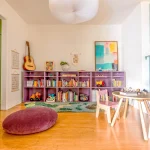
Paint Kitchen Cabinets : it’s hard work. Even prep work can be days in the making.
Clean your cabinets first to help the paint adhere. Sugar soap and water will do the job just fine, but enough power to resist the buildup of grease.
Preparation
Wipe all surfaces smooth with Krud Kutter degreaser using a rag or clean cloth before painting cabinets. This might be easier if you do it.
There is also the sanding needed to help the paint adhere to its surface, though this can be time-consuming and a chore. Finished: After it’s washed and sanded, painting ensues. It would be best to apply multiple thin coats rather than a single thick coat; also you would want to use enamel paint that is made for kitchen cabinets.
Cleaning
Even if you wipe as you go, kitchen cabinets can also get stained with obscured or hard-to-see food. Making bacon or simmering pasta sauce leaves grease marks that recolor the wood and need to be wiped off with regular cleaning.
Keep your wooden cabinet surface clean and avoid high frequency and frequent more extensive cleaning and maintenance work to save both time and money.
Krud Kutter or something like it is a great degreaser, apply it with a brush or soft cloth. Dirtex powder cleaner also works and is just three or five minutes before it can be wiped away with damp soft towel – do this on a flat worktop, otherwise cabinets will bounce around.
Sanding
Sanding is the first thing you need to do if you are changing the colour of your kitchen cabinets. Sanding creates a rough texture on which new paint can be applied; especially important when switching from gloss finish to matte or flat finish paint finishes.
Use Krud Kutter degreaser to scrub up grease or dirt off any areas you are going to sand down and then wipe it all down and vacuum so the dust doesn’t come flying off the surface.
Step five is not so fun, but it is part of the professional look you can achieve in your average-sized kitchen. This takes about 3-5 days on average to go through all this for a standard kitchen with two veterans.
Primer
Regardless of the paint you’re painting on, primer is a necessary part of how your finished paint finish will adhere and last. A good primer will also help stain to disappear and makes a super smooth surface to apply finishes to.
Apply an oil or shellac primer like BIN. Great product on wood, both bare and laminated and pre-painted wood surfaces, quick drying, and blocks stain well. It’s also low VOC so you won’t get toxic fumes if you apply it properly!
Be sure the surrounds are properly tarpaulin’d or sheeted so as to not get primer/paint on things that you aren’t painting, and take the extra step of removing cabinet doors and drawers so you can do them at their own work stations.
Paint
You might also need cabinet oil or latex paint if your cabinet material has special cabinets. A bonding primer of high quality might also be needed before multiple thin coats of paint for a full, even application.
Cabinet paint for kitchen comes in various colors like satin, semi-gloss or gloss. Satin and semi-glosses are very hardwearing and they reflect more light to make your space look larger and brighter.
Eliminating all hardware is perfect before painting doors and drawers so paint drips off of handles and hinges do not happen. : If not, masking tape any frames edges so there is no mess.






